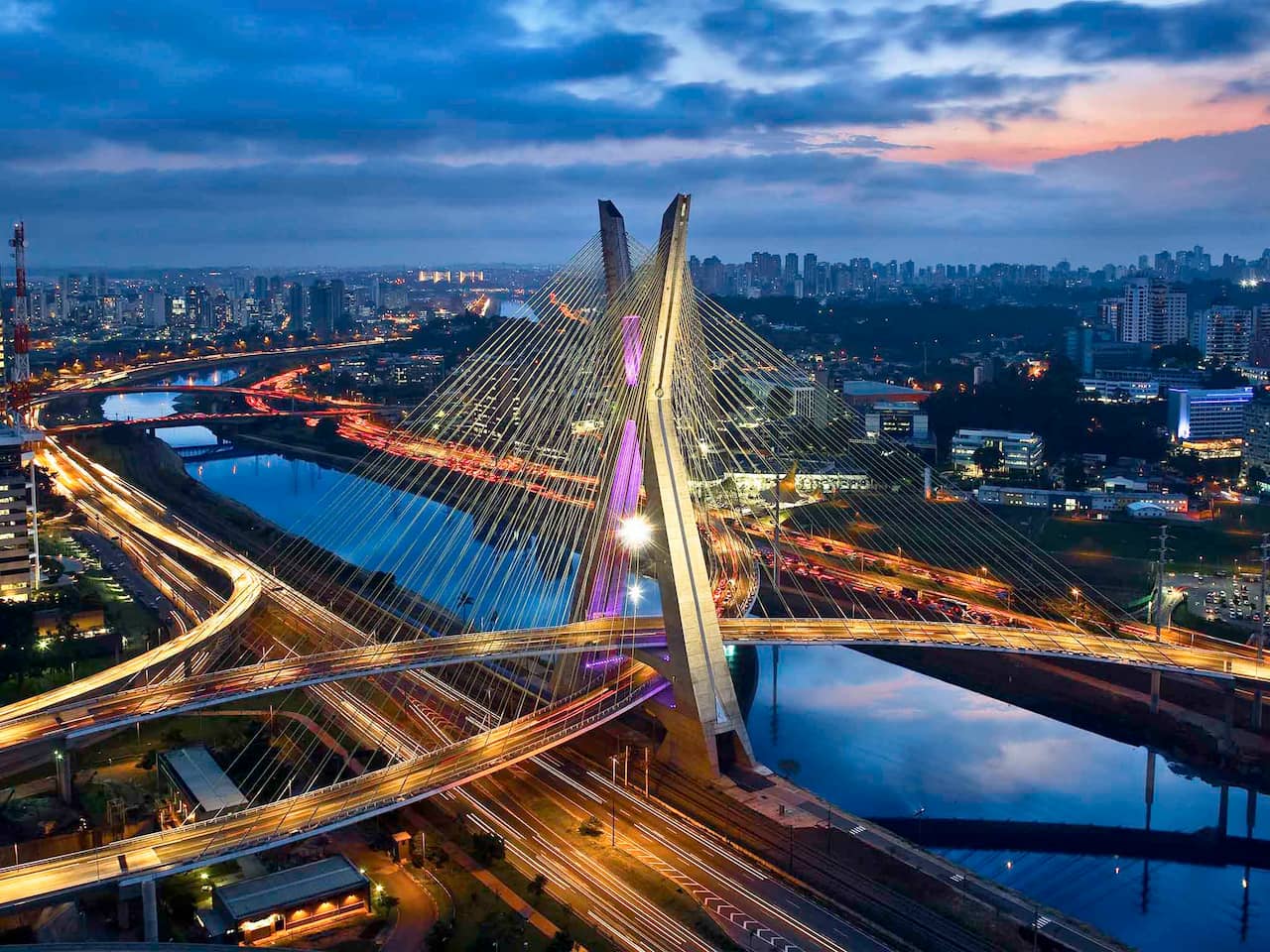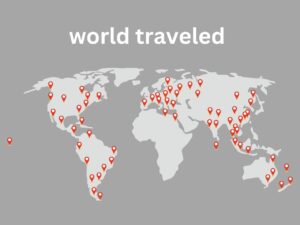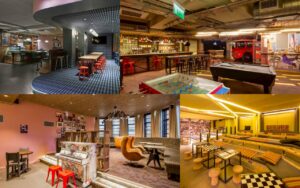São Paulo is the heart of Brazil, being its economic, financial, industrial and cultural center. In the 2022 census, the capital had approximately 12 million inhabitants (22 million in the metropolitan area).
One of the 5 largest cities in the world, considered a concrete jungle, its skyscrapers and large urban sprawl give the impression of being overwhelming and chaotic.
Even for me, who has lived here all my life, it is not a beautiful city, but the exuberance of options makes it a must-see.
São Paulo, or Sampa, as we locals call it, has the status of a business city, but don’t be fooled.
Although the endless corporate towers and high-rise condominiums may give the impression of a place committed to all work and no play, nothing could be further from the truth.
It is a vibrant city with a gastronomic and cultural diversity that would make any city in the world envious.
One of the great things about São Paulo is that you can find whatever you want at any time of the day or night, you just have to know how to look. The city never sleeps.
A little history of São Paulo:
São Paulo has always been very important in the development of Brazil.
Initially, it was an important center for exploration in the center of the country, and with the discovery of gold in Minas Gerais, its importance increased.
However, with the production of coffee and later industrialization, it consolidated itself as the most important city in the country.
Foundation and Early Years.
- 1554: São Paulo was founded by Jesuits, including Manuel da Nóbrega and José de Anchieta, on January 25, as a school to catechize the indigenous people.
- 16th and 17th centuries: The city began to grow slowly, serving as a base for bandeirantes, explorers who entered the interior of Brazil in search of riches and indigenous slaves.
- 18th century: With the discovery of gold in Minas Gerais, São Paulo became an important transit point for miners.
- 19th century: Coffee production became the main economic activity, driving the city’s growth. The arrival of immigrants, mainly Italians, Japanese, Portuguese and Spanish, transformed the city even further.
Industrialization and Modernization.
- Early 20th Century: São Paulo rapidly industrialized, becoming the economic center of Brazil. The city saw an influx of rural workers and immigrants, which accelerated its population growth.
- 1950s and 1960s: The government invested in infrastructure, including the construction of major avenues such as Avenida Paulista, and the city established itself as Brazil’s leading metropolis.
- Late 20th Century and Early 21st Century: São Paulo continued to expand, facing challenges such as chaotic traffic and social inequality, but also standing out as a cultural, financial, and gastronomic center.
- Today, São Paulo is the largest city in Brazil and Latin America, a true cultural melting pot known for its diversity, large-scale cultural events, vibrant nightlife, and dynamic economy.
Main attractions in Sao Paulo
1. Walk along Paulista Avenue.
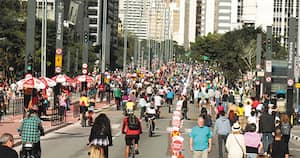
One cannot talk about São Paulo without mentioning Paulista Avenue. Even though it no longer has the financial importance it once did, it is still a symbol of the city’s progress.
The avenue is best visited on a Sunday, when it is pedestrian-only and closed to traffic.
It is home to one of the most important museums in Latin America, MASP, among other attractions.
Right in front of MASP, take a break in the dense vegetation of Trianon Park, one of the few green spaces on the avenue.
2. Explore MASP, the most important museum in Latin America

One of Brazil’s premier museums, with unique architecture, officially called the São Paulo Museum of Art, but everyone calls it MASP.
It’s a glass and concrete giant designed by famed Brazilian architect Lina Bo Bardi that houses a massive collection of over 8,000 pieces of art.
The main attraction is its collection of modern European art (the largest of any museum in the Southern Hemisphere), but you’ll also find excellently curated exhibitions of Asian, African, and American art.
Check out the museum’s website for a list of temporary exhibitions, guest lectures, and all sorts of interesting programming.
3. See São Paulo from the top of Banespa/Farol Santander
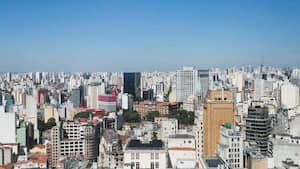
Although downtown São Paulo has been in disrepair for a long time, our city government is revitalizing the area.
One of the first was the “Edifício Altino Arantes” building, better known as the Banespa building because it housed the old Banespa bank. This is an art deco skyscraper inspired by the Empire State Building in New York.
The Santander bank transformed it into a center for culture, tourism, leisure and gastronomy, bringing creative ways of interacting with people and spaces. The restoration went beyond the walls and stories behind the lives of the people who passed through there. The revitalization of the space also came through art, with contemplative, immersive and biographical exhibitions of Brazilian and international artists and personalities.
Today known as Farol Santander, it is open to visitors.
See more details and buy your ticket here
4. Relax in Ibirapuera Park
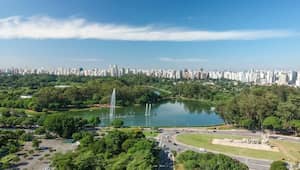
Considered the city’s green lung, it is one of the city’s main green leisure areas.
It is the perfect place to connect with nature, play sports and enjoy cultural activities.
The park has paved trails that are perfect for walking, running and even cycling.
As a result, it is always crowded, so if you want to avoid the crowds, come early in the morning.
The park is also home to several museums and iconic pieces of architecture, including structures by the famous Brazilian architect Oscar Niemeyer.
5. Explore Liberdade, the Japanese neighborhood.
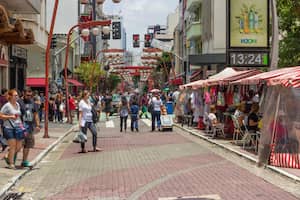
Brazil has the largest Japanese population outside of Japan, and the Liberdade neighborhood is known as the Japanese neighborhood.
The neighborhood is adjacent to the historic center and has numerous Japanese restaurants and shops.
It is home to the best restaurants serving Japanese bar food to accompany sake and beer, and dozens of mid- to high-end sushi bars. You can also browse through countless shops, markets, and street vendors selling everything from Japanese groceries to crafts, manga, and cheap electronics.
On Saturdays and Sundays, from morning to early afternoon, the Liberdade Fair is at its peak, and locals and tourists from all overcome to stroll, eat, and shop.
For a classic meal, go for gyoza and ramen at Aska Lamen, the best ramen restaurant in SP.
6. Great Municipal Market
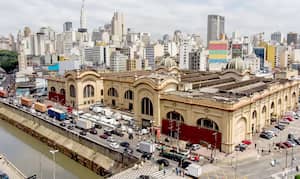
It is the largest and oldest indoor market in the country, built in 1897.
It has a variety of meats, roasts and sweets on the first floor, while the upper floor houses restaurants and souvenir shops.
There are many traditional restaurants to eat at and several souvenir shops, so be sure to take a stroll and explore the place.
7. Explore downtown São Paulo

Although it is important to note that walking around downtown São Paulo is not a very safe place to go.
It is worth visiting, but take the necessary precautions with your belongings.
Check out the 15 foolproof tips for traveling safely in any country.
The most common types of pickpocketing are petty thefts, so leave everything of value at the hotel and only take cash for what you need.
Visit the city’s neo-Gothic Sé Cathedral. Stand in the middle of the palm tree-lined sidewalk and gaze at the enormous green dome and twin towers, located in front of the city’s landmark.
A few meters away is the courtyard of the college where the Jesuit priests founded the city of São Paulo in 1554.
Going down Rua Boa Vista you will find the São Bento Monastery.
The Monastery of São Bento is one of the oldest churches in São Paulo, dating back to 1598. The beautiful carved ceiling and stunning stained glass windows make it a worthwhile stop on any visit to the city center.
The church bakery also sells tasty treats made by the monks themselves using centuries-old recipes.
More information about the Monastery of São Bento.
Leaving the Monastery, we have the iconic Santa Ifigênia Viaduct that crosses the Anhangabaú Valley overhead.
Then, just head down to the Anhangabaú “valley”, a huge square located in the heart of the city center.
It was completely renovated and reopened in 2022 as a fabulous new public space.
It is a favorite spot for people watching, rollerblading, skateboarding, and just sitting, reading, and contemplating.
It is a venue for outdoor events and concerts in the city of São Paulo.
8. Visit the Municipal Theatre
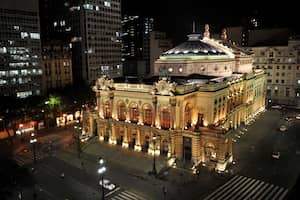
One of the most important monuments in the historic center of São Paulo is undoubtedly the municipal theater.
The Municipal Theater of São Paulo is an architectural and cultural gem of the city. Opened in 1911, the theater is known for its grandeur and historical importance in the Brazilian artistic scene.
In 1922, the theater hosted the Modern Art Week, an event that revolutionized art and culture in Brazil, marking the beginning of Modernism in the country.
Watching a performance or taking part in a guided tour is a unique experience that provides an immersion in the art and architecture of one of the most emblematic theaters in Brazil.
More information about the theater, schedule and tickets.
9. Eat a pork sandwich at Estadão
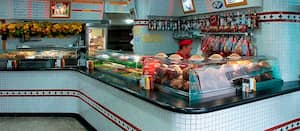
10. Admire the architecture at Luz Station and Luz Park
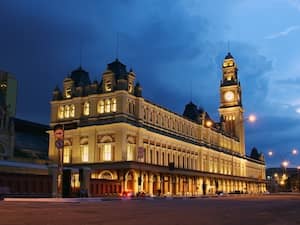
Luz train station is one of the largest train stations in São Paulo and is home to the train and a station on the yellow metro line. It is a Victorian-style building with an iconic clock tower.
The station played an important role in the development of São Paulo by connecting the port city of Santos with the coffee-exporting city of Jundiaí.
Parque da Luz is a large, winding green space located directly between Luz station and the Pinacoteca Museum. The park is perfect for getting some fresh air after a few hours at the museum.
11. Visit the Ipiranga Museum
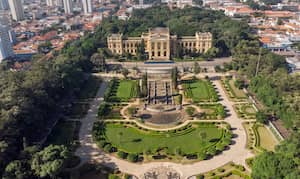
The Ipiranga Museum, built in the late 1800s as a monument to commemorate Brazil’s independence from Portugal, is a massive, elegant palace-like structure with landscaped parks and gardens surrounding it, which is reason enough to visit.
It has been renovated since 2013 and is set to open in 2022 to commemorate the bicentennial of Brazil’s independence.
Every day, thousands of people come to the park to walk along the tree-lined trails, bike, skateboard, and rollerblade along the wide avenues, and just relax in the sun.
The museum itself takes visitors on a journey through the city’s history, displaying historic artworks by famous local artists and artifacts from different eras of São Paulo’s development.
The museum’s most famous piece is the enormous painting “Independência ou Morte” by Brazilian artist Pedro Américo, which depicts the 1822 scene when Dom Pedro I declared Brazil’s independence on the banks of the Ipiranga River in São Paulo, adjacent to the museum.
Find out more on the museum’s official website.
12. Go to a steakhouse.
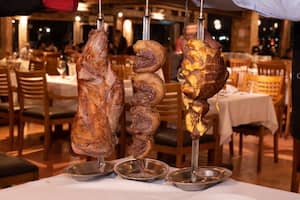
Barbecue is Brazil’s most famous culinary tradition, and steakhouses are where you’ll find it! In Brazil, you have 2 types of steakhouses: à la carte or rodizio. Rodizio is when waiters move around the dining room carrying skewers of meat straight from the grill, offering different cuts, all for a fixed price.
While barbecue is actually typical of the far south of Brazil, it’s something you’ll find in every region of the country. São Paulo has some of the best steakhouses in Brazil.
For an expensive but excellent meal, choose between Rubaiyat (à la carte) or two great rodizio-style places: Barbacoa and NB Steak. You can’t go wrong with either.
13. Enjoy São Paulo's nightlife.
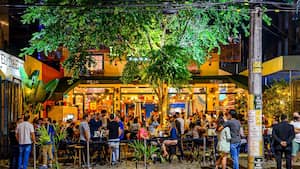
São Paulo’s nightlife is famous for its diversity and excitement, with options ranging from sophisticated to alternative, from bars and clubs to restaurants and live shows, guaranteeing fun for all tastes and styles.
The big problem is deciding where to go.
Every neighborhood has its nightlife attractions, but here are the most famous.
A. Vila Madalena.
The highlight of São Paulo’s bohemian scene. The central nightlife of São Paulo in the last decade, people from all over the city (and the surrounding region) come here to drink, dance and have fun in the dozens of bars and nightclubs, all within walking distance of each other.
- Bars and Pubs: Bar Astor, Boteco São Conrado and SubAstor.
- Restaurants: The place offers a wide variety of cuisine, from simple bars to gourmet restaurants.
- Atmosphere: Relaxed and artistic, with many art galleries and cool shops.
B. Rua Augusta.
The epicenter of alternative nightlife.
- Bars and Nightclubs: Z Carniceria, Tokyo 東京, Bar do Netão.
- Public: Diverse, with a mix of tribes, from rockers to electronic music fans.
- Highlights: Constant excitement, especially on weekends.
C. Itaim Bibi.
Elegance and sophistication.
- Bars and Restaurants: Eataly, Skye Bar (on top of the Hotel Unique), Nakka.
- Nightclubs: Casa 92, Pink Elephant.
- Profile: Frequented by young executives and a more sophisticated crowd.
D. Vila Olímpia.
Center for young and modern entertainment.
- Nightclubs: The Week, Villa Mix, The Year.
- Bars: Hooters, Bar Charles Edward.
- Attractions: Large clubs and themed bars, as well as many corporate events.
E. Jardins.
Chic and classic.
- Restaurants and Bars: Spot, Seen (on top of the Tivoli Mofarrej Hotel), Paris 6.
- Culture: Teatro Procópio Ferreira, Teatro Renaissance.
- Atmosphere: Refined, ideal for those looking for a quieter and more sophisticated night out.
F. Centro Histórico.
A mix of tradition and modernity.
Once practically avoided, this part of the city center is undergoing a renaissance (and rapid gentrification) and is a great place for an alternative night out with many casual bars, jazz bars and LGBTQ-friendly spots.
- Bars and Nightclubs: Bar da Dona Onça, JazzB, Tokyo.
- Cultural Spaces: Theatro Municipal, Praça Roosevelt with its alternative bars.
- Highlights: Large concentration of theaters and concert halls, as well as historic bars.
G. Pinheiros
Diversity and youthful energy.
Adjacent to Vila Madalena, Pinheiros has a more low-key vibe and is a better place for cool bars, sidewalk beers, and relaxed bar hopping.
- Bars and Restaurants: Cervejaria Nacional, Le Jazz, Pitico.
- Atmosphere: Relaxed, with plenty of outdoor spaces and a welcoming atmosphere.
- Profile: Frequented by young people and professionals.
H. Bixiga
Italian tradition with lots of music.
- Restaurants: Cantina Roperto, Famiglia Mancini.
- Bars: Bar do Alemão, Tubaína Bar.
- Attractions: Lots of venues with live music, especially samba and MPB.
Best time to visit Sao Paulo
São Paulo is a vibrant city, with attractions all year round, but each season has its own particularities.
Summer (December to February)
Average temperature between 20°C and 30°C, hot and humid weather, with frequent rain, especially in the afternoon.
A holiday season, with many parties and cultural events.
However, it is one of the times with the highest number of tourists, with crowded bars and restaurants.
Autumn (March to May)
Average temperature between 15°C and 25°C, with a drier and more pleasant climate, with little rain.
The ideal time to explore the city on foot and visit parks.
This is one of the best times to visit.
Winter (June to August)
Average temperature between 10°C and 20°C with dry and cold weather, especially at night.
Ideal for those who like the cold and want to avoid the rain. Gastronomic festivals and indoor events.
The nights can be quite cold, and some days can be cloudy.
People from São Paulo flee to the northeast and the city is very pleasant.
Spring (September to November)
Average temperature between 15°C and 25°C.
The weather starts to warm up, but still with pleasant weather and little rain.
The city is full of flowers, pleasant weather and many outdoor events.
Extra Tips
Special Events: Check out the city’s events calendar. Music, art and culture festivals can make your visit even more interesting.- Urban Exploration: São Paulo has many parks, museums and incredible restaurants. Regardless of the season, there is always something to do.
For a balanced experience, autumn (March to May) and spring (September to November) are generally the best times to visit São Paulo. The weather is milder and the city is full of life.
How to get to Sao Paulo.
São Paulo is one of the country’s main destinations and is well-connected by both air and land.
Plane
The quickest and most convenient way for most people to get there is by flying.
Main Airports:
- Guarulhos International Airport (GRU): The largest and busiest airport in Brazil, it receives both international and domestic flights.
- Congonhas Airport (CGH): Located closest to the city center, it serves mainly domestic flights.
- Viracopos Airport (VCP): Located in Campinas, about 100 km from São Paulo, it also receives both domestic and international flights.
How to Get to the City Center from the Airports:
- Guarulhos: Taxi, executive bus (Airport Bus Service) or train (CPTM Line 13-Jade).
- Congonhas: Taxi, ride-hailing apps (Uber, 99) or bus.
- Viracopos: Lirabus bus to Tietê Bus Terminal in São Paulo.
Bus
If you are in another Brazilian city or even in neighboring countries, traveling by bus can be a good option.
Main Bus Stations:
- Tietê Bus Terminal: The largest bus station in Latin America, with buses to national and international destinations.
- Barra Funda Bus Terminal: Serves destinations mainly in the interior of São Paulo and other states.
- Jabaquara Bus Terminal: Serves destinations on the southern coast of São Paulo.
Car
Traveling by car offers flexibility and can be a great way to explore more of the city, despite the traffic in the city being chaotic.
Main Highways:
- Presidente Dutra Highway (BR-116): Connects São Paulo to Rio de Janeiro and the states of the Northeast
- Bandeirantes Highway (SP-348): Connects São Paulo to Campinas and the interior of the state
- Anhanguera Highway (SP-330): Another option for those coming from Campinas.
- Régis Bittencourt Highway (BR-116): Connects São Paulo to the south of Brazil.
Getting around in Sao Paulo
For me, the best ways to get around are always on foot and by public transport.
That’s why I always stay close to attractions and/or public transport.
Since the main attractions in São Paulo are in the city center and nearby neighborhoods, public transport is the best option.
Especially since the traffic in the city is very bad and everything takes a long time.
Subway
The subway is one of the fastest ways to get around São Paulo, avoiding heavy traffic.
It connects several areas of the city, including tourist attractions and shopping areas.
It also easily connects with CPTM trains and municipal buses. Since traffic is very heavy, it’s a good idea to avoid rush hour (7am-9am and 5pm-7pm) for a more comfortable trip.
Buses
Municipal and intercity buses cover almost the entire city and metropolitan region.
The main roads have exclusive bus lanes, improving travel speed.
Transportation Apps (Uber, 99, Cabify)
Great for quick and personalized trips, especially outside of peak hours. With more affordable prices.
Check the dynamic rates and choose times of less demand to save money.
Taxi
Although they are more expensive than apps, taxis can be easily found throughout the city.
They are usually regulated and offer a reliable service.
Prices are measured by taximeter.
Bicycle
In recent years, the city has been improving its bicycle infrastructure.
It is a great option for those who care about the environment.
However, it is important to pay attention to safety, as the city is not yet completely bicycle-friendly.
Use bike paths and bike lanes for greater safety, and there are bike-sharing services (such as Bike Sampa) spread throughout the city.
Car
Since the city is very large and if you are going to travel beyond the center and for those who need autonomy and privacy, it is best to use a car.
However, it is the most expensive option, because in addition to traffic, parking in São Paulo is very expensive.
Pay attention to the vehicle rotation system and parking zones, and use navigation apps to avoid traffic jams.
Walking
If you plan well, much of your trip can be done on foot, which is an excellent option for your health and allows you to explore the city more closely.
The combination of public transport and walking is undoubtedly the best cost/benefit option.
However, always put safety first.
What is the best neighborhood to stay in São Paulo?
São Paulo has a wide variety of neighborhoods, each with its own characteristics and advantages.
Balancing what you want to do in the city with where to stay can make all the difference in the success of your trip.
Choosing the ideal neighborhood depends on the type of experience you are looking for in São Paulo. Jardins and Bela Vista are great for those who want to be close to the main tourist attractions, while Vila Madalena and Pinheiros are perfect for lovers of nightlife and alternative culture. Moema and Itaim Bibi are ideal for those looking for comfort and security, with good leisure and gastronomic options.
1. Jardins
This is one of the safest neighborhoods in São Paulo, close to Avenida Paulista, with easy access to the subway and several tourist attractions.
The neighborhood has many luxury stores, gourmet restaurants and charming cafes.
2. Vila Madalena
Known as the bohemian neighborhood, due to its vibrant nightlife, it is relatively safe, especially during the day.
Ideal for those who enjoy nightlife and alternative culture.
Easy access by subway and bus.
3. Pinheiros
A safe place, with many leisure and cultural options, close to Vila Madalena and easy access to public transportation.
With a variety of restaurants, diverse cuisine, from street food to sophisticated restaurants.
There are many events on the weekends.
4. Bela Vista
Bela Vista is one of the traditional neighborhoods, moderately safe, with busier and well-policed areas.
Many theaters, Italian restaurants and the famous Rua Augusta and 13 de Maio.
Its location close to the center and Avenida Paulista makes it easy to access public transportation.
5. Moema
One of the safest neighborhoods, ideal for families, close to Ibirapuera Park and Congonhas Airport.
It mainly has shopping malls like Ibirapuera, bars and sophisticated restaurants.
6. Itaim Bibi
Considered safe, especially in the busiest areas.
It is a more business-oriented neighborhood, far from the main attractions and with more difficult access to public transportation.
However, it has excellent high-end restaurants, bars and shopping malls.
7. Brooklin
Another business-oriented neighborhood, relatively safe, especially in busier areas, located near the Business Center and Morumbi Shopping Mall.
Ideal for those who need to be close to the Business Center and large companies.
Where to stay.
Over time, the way people travel and stay has changed.
I’ve been to 5-star hotels and hostels with shared rooms for up to 10 people.
Nowadays, I’ve been looking for a new way to stay, which is a mix of Airbnb and hotels.
They are “apartments”, small or not, with the infrastructure to cook, which means that in addition to having more privacy, you save on the cost of meals and you’re not paying for infrastructure that you don’t use, such as a swimming pool, gym, etc.
They are classified as budget and medium, but with significant savings.
I’ll explain more here.
Budget:
Vila Rock Hostel
Located just 600 m from the Sumaré Metro Station, Vila Rock has a barbecue, free WiFi and a TV room with movies and billiards.
Located near Allianz Parque, Vila Madalena, Av Paulista and very easy to get around by public transportation.
Medium:
The Landmark Residence
The hotel offers a hearty breakfast, a swimming pool, a squash court and a gym. Wi-Fi is free.
Located 2 blocks from Consolação subway station and the famous Paulista Avenue.
The Landmark Residence features air conditioning, an extra living room with cable TV and a kitchenette with a minibar. Apartments have a Smart TV, a hot tub and a private balcony. Rooms with reduced mobility are available.
LUXURY:
Regent Park Suite Hotel
A 4-star hotel with modern rooms featuring cable TV, a balcony with city views, a kitchen and a living area. The private bathroom has a hairdryer and free toiletries.
The Michelin-starred Picchi Restaurant features well-defined Italian flavors and innovative touches with Brazilian ingredients.
The hotel is just a 7-minute drive from Paulista Avenue and Faria Lima. You will also find famous shops and restaurants nearby.
Gastronomy in Sao Paulo
A cidade é um verdadeiro paraíso gastronômico, com uma culinária rica e diversificada que reflete a mistura cultural da cidade.
Cada prato típico conta uma parte da história e da tradição paulistana.
 Virado à Paulista:
Virado à Paulista:
A complete and traditional dish, consisting of rice, black bean stew, sautéed cabbage, pork rinds, sausage and fried egg.
 Feijoada:
Feijoada:
Black bean and pork dish, served with rice, farofa, sautéed kale and orange. Traditionally served on Wednesdays and Saturdays.
 Pizza Paulistana:
Pizza Paulistana:
Made with thin, crispy dough and topped with high-quality ingredients, São Paulo is known for having some of the best pizzerias in the country.
Mortadella Sandwich:
French bread stuffed with a generous amount of mortadella, famous for its size and flavor.

Pastel de Feira:
Fried pastry with a variety of fillings, such as meat, cheese, hearts of palm and shrimp. Sold mainly at street fairs.
Coxinha:
Fried snack made from potato and flour dough, stuffed with shredded chicken and sometimes Catupiry.
3-day itinerary in Sao Paulo
On the first day, it is best to stay downtown, taking due care to ensure safety and avoiding the worst places like Cracolândia and going out at night.
Due to the number of attractions and the distances, São Paulo is one of the cities that requires more than two days to explore.
I am planning a 3-day itinerary, but the ideal is to stay for 5 days, especially if you are visiting during the festive season like Carnival and other events.
Since the city is very large and not very easy to get around, although there are all types of transportation, it is essential to plan well so as not to waste too much time, since traveling 5 kilometers can take hours.
Information about public transportation
Uber works very well in São Paulo.
For the main transportation information, contact the municipal transportation company, SPTRANS.
See information about the subway here.
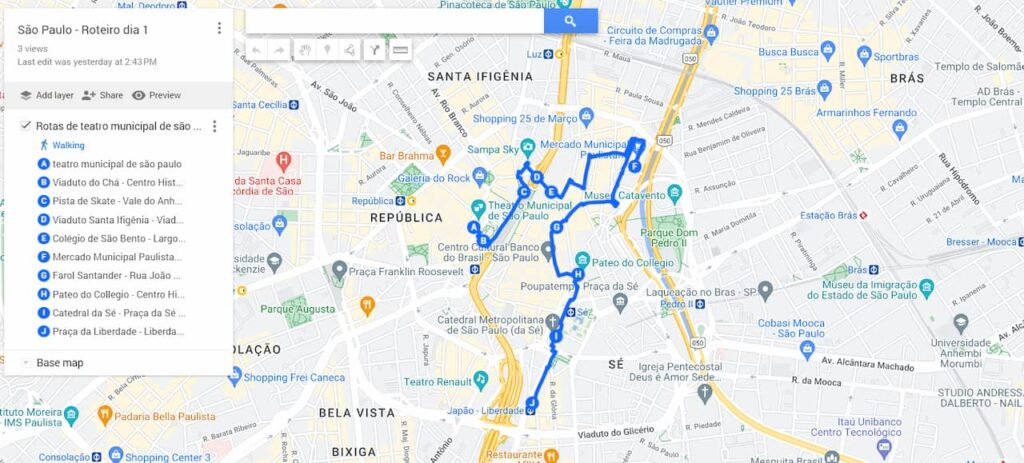
Before starting the itinerary, I must warn you that although safety in São Paulo is basically the same as in any major city in the world.
Here are some safety tips that apply to any place.
I have to admit that it is best to be extra careful.
In general, what can happen is that you may have your cell phone stolen and/or be mugged, with your belongings taken.
I would like to emphasize the importance of not wearing valuable clothing, jewelry, etc. that attracts attention.
As always, keep your passport and credit cards in a safe place.
And most importantly, do not walk around with your cell phone in your hand and do not pay attention to what is happening around you.
Carry as little valuables as possible with you.
With these precautions, your visit will be memorable.
First Day: See attractions in the city center.
We started the day by visiting the area around the Municipal Theater. For those who want to visit the attractions, here is the information
There is the option of guided tours of the interior, which allow you to visit the basement to the dome of the building, which dates back to the early 20th century. The times vary depending on the day of the month and you need to check the website. But they always take place from Tuesday to Saturday.
In the surrounding area, we have the Praça das Artes, Galeria do Rock, Monument to Ramos de Azevedo and many historic buildings
Right in front of us is the Viaduto do Chá and, going down the stairs, you reach the Vale do Anhangabaú.
The valley has now been renovated and is a large center for outdoor activities in the city.
Continuing through Praça do Correio, you reach the Viaduto Santa Ifigênia, which has a privileged view of the Vale do Anhangabaú.
As soon as the viaduct ends, there is the Mosteiro de São Bento.
See more details about the visit here.
Break for rest and lunch
You must be feeling hungry by now and there is nothing better than enjoying the delights of the Mercado Municipal.
The “Mercadão” has wonderful stained glass windows depicting 20th century agriculture, fruit stalls (some exotic), spice stalls and, on the upper floor, a mezzanine with several snack bars and restaurants.
The most famous are the pastéis (the most famous flavor is codfish) and the mortadella sandwich.
The sandwiches are huge, as are the pastéis and are good for lunch.
On the way, you will visit one of the largest shopping centers in São Paulo.
I am talking about 25 de Março, which is a popular mecca for those who like to buy super cheap things, with little shops and thousands of street vendors.
People come from all over Brazil and other countries to shop.
After a rest and enjoying the various gastronomic options at the Market, it is time to continue.
You can explore the region by heading towards Farol Santander, which is a cultural center.
Start your tour on the terrace, where you will see the view of the buildings in the city center. Then, go down the stairs, because the stairs themselves have attractions, such as walls painted in a way that creates an optical illusion.
Another attraction is the gigantic chandelier in the entrance hall.
After the visit, continue towards the Pátio do Colégio, a building built to house a Jesuit school, where the city of São Paulo was born, and soon after the Sé Cathedral (Metropolitan Cathedral), one of the city’s landmarks.
Downtown São Paulo
Just before reaching the main entrance of the cathedral, there is an avenue with imperial palm trees and the zero mark, where all the measurements of São Paulo begin.
And to end the day, a stroll through the Liberdade neighborhood, the heart of oriental culture in São Paulo.
The neighborhood has streets with oriental lanterns, little shops selling swords and geisha clothes, as well as typical food products.
On Saturdays, from 9am to 6pm, and on Sundays, from 9am to 7pm, there is a craft and food fair there.
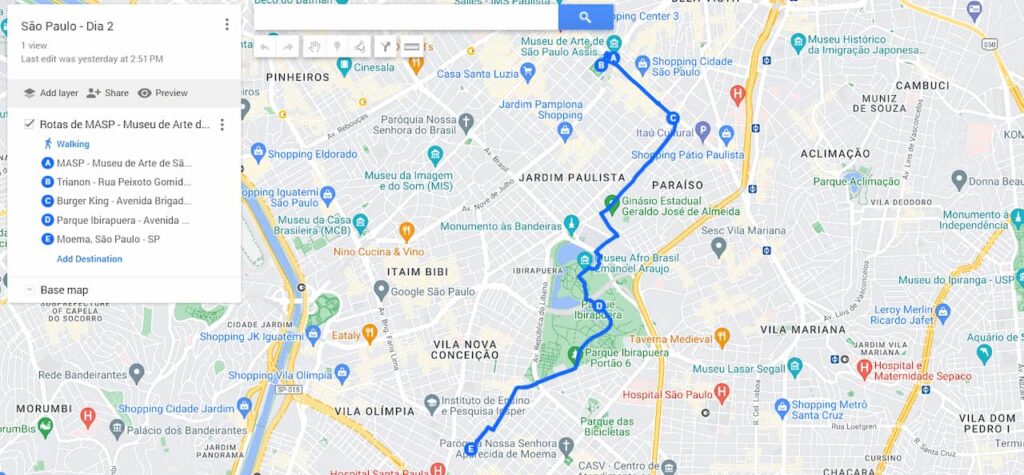
Second day: Paulista and Ibirapuera Park.
The itinerary needs to be planned, since visits to MASP must be scheduled and Ibirapuera is far away.
See how to buy tickets.
To make the most of your visit, it is a good idea to reserve 2 to 3 hours to appreciate all the works and exhibitions.
It has 8 thousand pieces of paintings and sculptures by renowned artists, such as Rodin, Van Gogh and Monet, as well as temporary exhibitions.
After the visit, cross the street and stroll through Trianon Park, a green area right in the middle of the concrete world, and then walk back along Paulista Avenue towards Brigadeiro Luiz Antônio Avenue.
This is a great time to enjoy the gastronomic options in this area, because later, in Ibirapuera Park, the best time to enjoy the largest green area in the city is in the city.
In addition to offering great cultural options, Ibirapuera Park is also the perfect place to practice physical activities, as it is well located and very well maintained.
It is the most visited park in Latin America, with approximately 14 million visitors, and is also one of the most photographed places in the world.
At the end of the day, there is nothing better than ending up in one of the most chic and bohemian neighborhoods in São Paulo.
The Moema neighborhood has shopping malls such as Ibirapuera, bars and sophisticated restaurants.
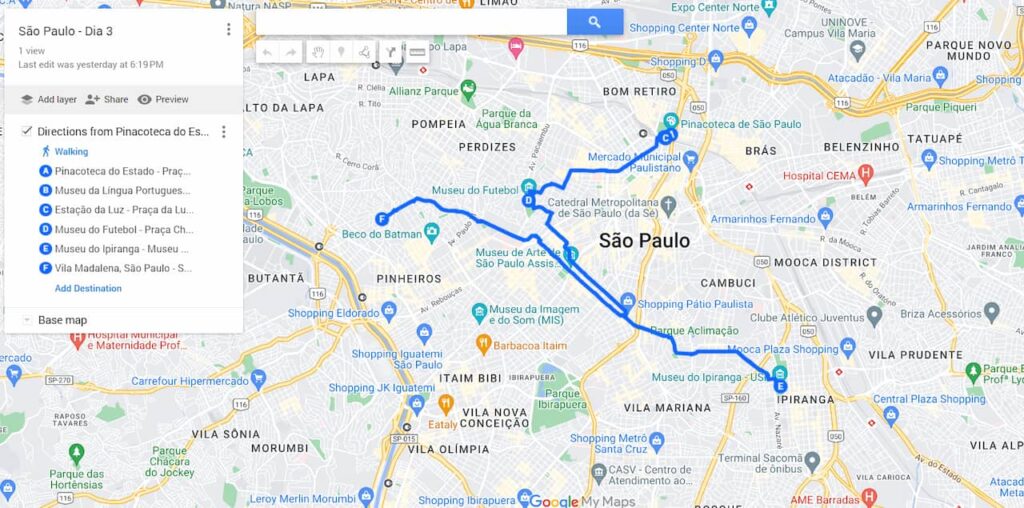
Third day: City museums.
We start the day at the Pinacoteca, a brick building where you can see classic works, sculptures by Rodin, paintings by Portinari and a collection of Brazilian art from the 19th and 20th centuries.
A few steps away, the Museu da Língua Portuguesa is the visitor’s meeting point with language, literature and history, displayed through audiovisual resources and cutting-edge technology. Instead of walls, voices. Instead of works, interactive spaces.
Next door, we have the Luz station, which was designed by Barão de Mauá to succeed the first station in 1867.
The structure was entirely imported from England and was inspired by an Australian station, Flinders Street Station, located in Melbourne.
By public transport or taxi, we can go to the Museu do Futebol, one of the best and most beloved museums in São Paulo.
Brazilians are crazy about soccer and the museum has a permanent exhibition with holograms of players, videos of athletes, commentators talking about their favorite goals or games and audio narrations of goals from the past.
Everything about soccer and its history.
Lunch break
As public transportation is more complex, it is best to use a taxi or Uber to get to the Ipiranga Museum.
The Ipiranga Museum is the headquarters of the Paulista Museum, which is a museum specializing in history and cultural material and is part of the University of São Paulo.
The building that now houses the exhibitions and spaces for educational and cultural activities was designed to be a monument to commemorate the Proclamation of Independence, which took place in 1822.
To end the night, there’s nothing better than visiting one of the trendiest neighborhoods in São Paulo, Vila Madalena
Vila Madalena became a bohemian stronghold in São Paulo back in the 1980s. Today, countless bars, restaurants, galleries, graffiti, clubs and shops are scattered throughout the streets, making the area extremely eclectic.
How much does it cost?
3 styles and their costs
Backpacker:
Staying in hostels using shared dormitories, cooking your own meals and/or local and cheap restaurants, using local transportation, exploring the city on foot and taking free or cheaper tours.
Daily expenses: US$40.00 to US$60.00 per day
Intermediate:
Staying in hostels/budget hotels in private rooms, eating at average restaurants, going to the main paid attractions, using some taxis and Uber.
Expenses: US$100.00 to US$140.00 per day.
Luxury:
Staying in the best hotels, going to all the attractions, hiring more sophisticated packages such as helicopter use, etc.
Daily expenses: US$220.00 and above per day
